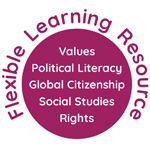Identity and a sense of belonging stem from a complex mix of factors. From family and community, from your country and also from the circumstances of your life. Does your sense of who you are change if the circumstances of your life change?
Learners consider their own identity and what factors influence their sense of belonging. They examine why people leave home, sometimes against their will, and develop empathy for displaced people. They examine the movement of displaced people into and out of Israel and Palestine.
Research question:
How might your sense of identity and belonging change if you were displaced?
Resources Levels 3-4
Core Activities
- Identity profile: famous person case studies, famous person profile and personal profile
- National identity: What makes you Scottish? And identity-we-are
- Who makes you feel safe and that you belong? my-world-triangle-scotland and my-world-triangle-conflict and three-wishes-israeli-and-palestinian-children-speak
- Basic facts Israel and Palestine: fact-finding-mission
- Movement of people: why-do-people-move and movement-of-people-israel-and-palestine
- Information on the Internet outline
- Report
Extension Activities
- People’s Stories
- Poem dislocation-poem
- Interactive simulation, What would you do?
- From The World’s Largest Lesson
- Humanitarian Perspective: worlds-largest-lesson and humanitarian-perspective-outline and from The Guardian newspaper website My Neighbourhood film (25 mins)
Notes on Core Activities
Activity one: Identity profile. People are complex, we cannot be summed up by a single characteristic. This exercise from Show Racism the Red Card, lets learners consider the different aspects of the identity of a famous person and also consider what makes them the person they are. Each student selects and reads a profile of a famous person and tell the others in the group what they have learned, mentioning anything they found surprising. Complete the identity profile for their case study and then one for themselves.
Activity two: National identity. Learners explore what makes them Scottish and who they are.
Activity three: Learners use the My World Triangle to consider who keeps them safe and then complete a triangle for someone living in a place of conflict. The case studies from Three Wishes: Israeli and Palestinian Children Speak can be used here.
Activity four: An introduction to basic facts about Israel and Palestine.
The cards can be printed out and placed around the room for learners to explore to complete the table.
Activity five: Learners consider the different reasons that people leave their home and explore movement of people in Israel and Palestine between 1948 and 1951.
Activity six: Students learn how to be critical about the information they find on the internet. They look for websites of well-known organisations and websites providing information on Israel and Palestine and complete the tables.
Activity seven: Assessment activity. Write an informative report, using the information learned about why people move and in particular movement of people in Palestine and Israel.
Extension Activities
Activity one: Peoples’ Stories. Read the case studies. In groups, learners discuss and decide which human right fits each case study. Some people chose to stay and some to leave. Look at the reasons for leaving or staying and match to the case studies. Learners role play one case study and interview each other about their experiences.
Activity two: Learners study the poem Dislocation by Scottish poet Sheila Templeton.
Activity three: This interactive resource from Channel 4 allows students to put themselves in the position of someone forced to leave home. They make decisions along the way and witness the resulting consequences.
Activity four: There are times when there is no simple answer to a problem. The lesson, Humanitarian Perspective- Is there only one way? from The World’s Largest Lesson, helps learners view the situation from a humanitarian point of view: that is by looking at the impact on the people involved. Students do Activity 2 using the story, The Brave Shopkeeper. Students watch the film, The Neighbourhood and repeat the exercise using information from the film and considering different voices from within each community.
